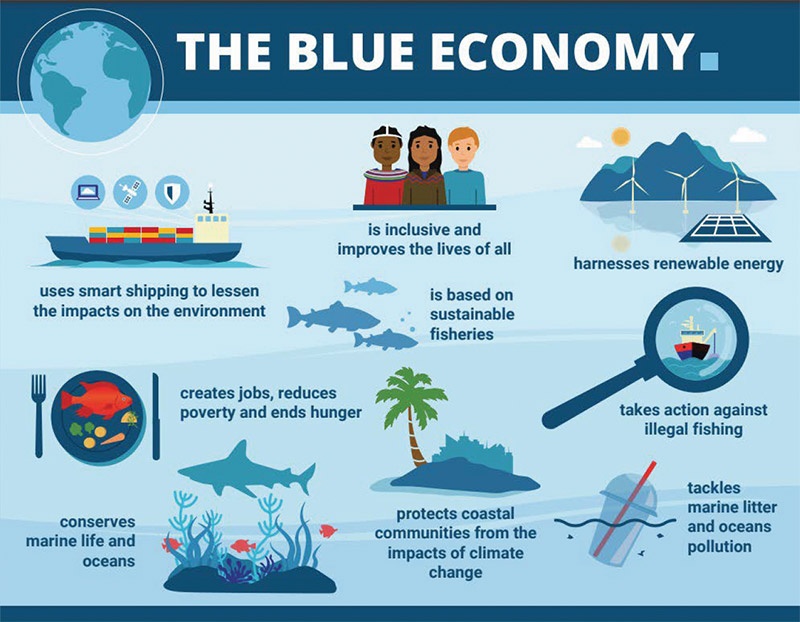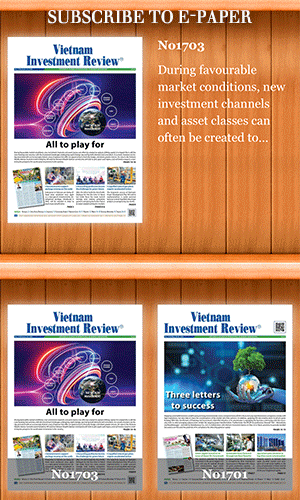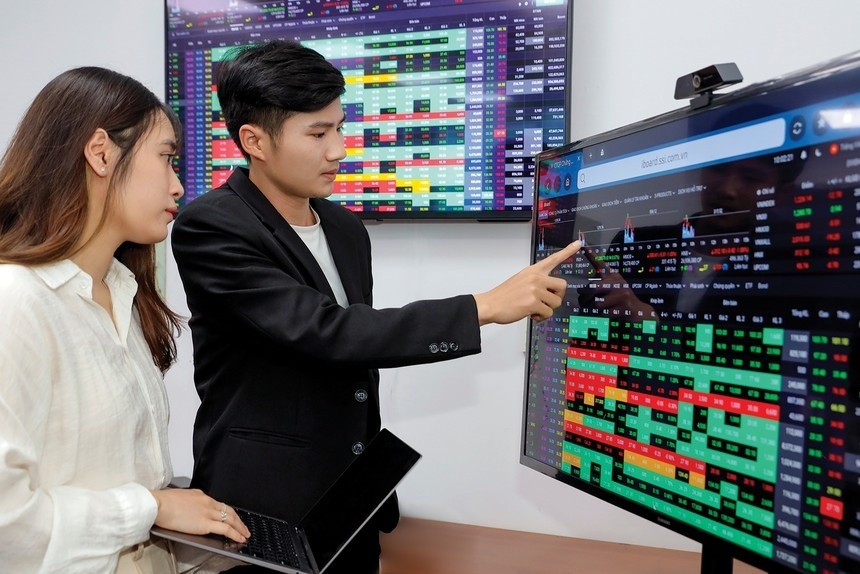Blue economy model gathering pace
The United Nations Development Programme (UNDP) last week again warned that the ocean is faced with increasing threats and multiple risks posed by climate change, natural disasters, environmental pollution, over-exploitation of natural resources, and unsustainable economic activities.
“Global warming and marine litter are threatening marine resources, including widespread bleaching of coral reefs. Globally, an estimated 8-20 million tonnes of plastic enter the ocean every year. In Vietnam, around 2,000 tonnes of plastic waste leaks from the country into the ocean every day. It is estimated that there will be more plastic than fish in the ocean by 2050,” said Caitlin Wiesen, resident representative in Vietnam of the UNDP.
The global ocean economy contributes an estimated $3 trillion per year, or about 5 per cent of the world’s GDP and comprises industries ranging from oil and gas, shipping and ports to renewable energy, fisheries, marine ecosystems and tourism. The value of the marine economy in the APEC region alone was estimated to be $2.06 trillion in 2015, contributing approximately 4.7 per cent of APEC’s total GDP.
“In Vietnam, the ocean economy is expected to contribute up to 10 per cent of GDP by 2030,” Wiesen said.
The ocean covers more than three-quarters of the planet and absorbs up to 30 per cent of CO2 produced by humans. Vietnam’s long coastline of more than 3,200km provides great natural capital for economic growth for its 28 sea and coastal provinces. Vietnam’s coastline and seas offer significant potential for onshore and offshore wind power, which, if sustainably developed, will support energy security and help Vietnam meet its commitment of net-zero emissions by 2050.
 |
Greater benefits
The Vietnam Administration of Sea and Islands under the Ministry of Natural Resources and Environment and the UNDP last week released a hallmark report titled “Blue economy scenarios for Vietnam” which is one of the first studies on marine economic development in Vietnam with the use of the concept of the blue economy.
This report, one of the first studies on blue sea economic development in Vietnam, focuses on the contribution of the blue economy to the nation’s socioeconomic development, supporting the realisation of the objectives of the country’s Strategy for Sustainable Development of the Marine Economy until 2030 and with a vision to 2045.
Moreover, it can assist Vietnam in meeting its stated goals of socioeconomic development, sustainable use of marine resources, and achieving net-zero emissions by 2050.
The report highlights blue scenarios in marine economic development for Vietnam, covering six key sectors including fisheries and aquaculture; marine renewable energy; oil and gas; coastal and marine tourism; maritime transport; and environment and ecosystems.
Under the report, for each economic sector, two scenarios were developed for 2030. These included, firstly, a baseline scenario that reflected existing and planned policy and strategies set by the governmental administrations of Vietnam within each sector to 2030, and secondly, a blue scenario aimed to optimise socioeconomic and environmental benefits.
The blue scenarios led to increases in GDP beyond the baseline scenario. They lead to benefits over and above the baseline scenarios in terms of GDP for all marine sectors in comparison with the baseline scenario.
Under the study, with the blue scenario applied, the GDP will be about VND296 trillion ($12.9 billion) more than the baseline scenario by 2025, and VND538 trillion ($23.5 billion) more by 2030. The sector-based intervention in each of the scenarios leads to progressive enhancement of GDP, suggesting that there is further substantial economic productivity potential beyond baseline policy arrangements.
The scenarios led to increases in gross national income (GNI) per capita beyond the baseline scenario. By 2025, under the baseline scenario, GNI per capita will be VND147 million ($6,390), while under the blue scenario, it will be VND230 million ($10,000). Similarly, in 2030, under the baseline scenario, GNI per capita will be VND163 million ($7,100), while under the blue scenario it will be VND290 million ($12,600).
“This increase in GNI per capita mainly reflects the growing economic productivity as measured by GDP promoted by strengthened policies in the blue economy sectors,” said Jeremy Hills, head of the study team.
Top recommendations
Vietnam’s Strategy for Sustainable Development of the Marine Economy until 2030 and with a vision to 2045, which has outlined the country’s vision, orientation, and commitment, can be further enhanced by targeted sector-based recommendations and strengthening marine environmental regulations. Further support can also be provided by marine areas to achieve net-zero emissions by 2050.
A sector-based policy recommendation has been advanced to achieve the blue scenario trajectory.
Specifically, the fisheries and aquaculture sector needs to reduce fisheries catch to maximum sustainable yield (equivalent to 2.7 million tonnes a year) through an annual 2 per cent catch reduction, including a decrease of near- and middle-shore vessels horsepower of 5 per cent a year; maintain aquaculture area but implement technical; and management improvement leading to a secure productivity increases of 3.5 per cent annually.
Meanwhile, the oil and gas sector needs to promote energy-saving within oil and gas production activities, enhance environmental protection; and increase participation in the emerging marine renewable energy production.
For marine renewables, it is necessary to boost the rapid expansion of marine renewables achieving 10,000MW installed by 2030, including about 4,500MW of near-shore wind (mainly in the Mekong Delta), and 5,000MW of offshore wind (mainly in the south-central region).
For the marine tourism sector, it needs to promote growth for international visitors by 8-10 per cent a year, and domestic tourists by 5-6 per cent a year to 2030; achieve 1.6 million tourist beds with 65 per cent occupancy by 2030; and embed climate change impacts, including sea-level rise, in tourism planning.
As for marine transport, it needs to increase maritime transport to 20.6 per cent of market share by 2030, increase the volume of goods transported to 787 million tonnes, and expand inland transport to 289 million tonnes.
| Dr. Ta Dinh Thi - Vice chairman National Assembly Committee on Science, Technology, and Environment Vietnam is a marine country with a coastline of more than 3,260km and over 3,000 islands, including two archipelagos. The marine economy is an important driving force for socioeconomic development, environmental protection, and international cooperation. The population in coastal provinces and cities accounts for more than 50 per cent of those in the country, with the majority of the labour force here working in marine economic sectors. Twenty-eight coastal provinces and cities contribute over 60 per cent to the national GDP. The ocean economy and marine economic sectors play an increasingly important role in the economic recovery from the impact of COVID-19 and promote economic growth in the country. However, Vietnam’s marine economic development is not sustainable. It has not been harmoniously linked with social development and environmental protection but also ensures defence and security, external relations, and international cooperation. Pollution and environmental incidents in some places in the sea and coastal areas are still serious, plastic waste pollution has become an urgent problem; marine ecosystems and biodiversity is reduced; and related resources are unsustainably exploited. Fully recognising the important role and contribution of the marine economy, Vietnam has promulgated various policies and actions for its sustainable development. These include Resolution No.26/NQ-CP in 2020; and Directive No.31/CT-TTg in 2021 on renewing and strengthening the implementation of the Strategy for Sustainable Development of the Marine Economy until 2030, and with a vision to 2045. The blue economy is a development trend in the world, especially for marine countries. The report “Blue economy scenarios for Vietnam” is one of the first studies on the issue using the concept of the blue economy. The report clarifies the concept of the blue economy and provides an assessment of several of Vietnam’s marine economic sectors, thereby identifying potential and building future scenarios. The report brings forward several important recommendations to promote the blue economy in Vietnam, contributing to the successful implementation of the marine economy strategy and the UN’s Sustainable Development Goals, including the goal regarding related resources and the environment. |
What the stars mean:
★ Poor ★ ★ Promising ★★★ Good ★★★★ Very good ★★★★★ Exceptional
Related Contents
Latest News
More News
- Korean Energy Agency seeks investment opportunities in Can Tho (July 19, 2024 | 17:33)
- PV Power proposes 4-billion-USD clean energy complex in Ninh Thuan (July 19, 2024 | 17:28)
- Sanofi strives to ensure environmental compliance (July 18, 2024 | 19:32)
- PV Power to develop $3.98 billion clean energy complex in Ninh Thuan (July 18, 2024 | 19:27)
- Home Credit Vietnam releases annual Sustainability Report 2023 (July 17, 2024 | 12:07)
- Leather and footwear industry to innovate for global competitiveness (July 17, 2024 | 11:48)
- Ben Tre selects wind power as pillar for coastal development (July 16, 2024 | 19:16)
- Levanta Renewables to acquire rooftop solar system in Vietnam (July 16, 2024 | 19:03)
- Public and private sector cooperate to boost sustainable forest development (July 12, 2024 | 14:18)
- Samsung Electronics Vietnam to expand renewable energy procurement (July 12, 2024 | 12:23)




 Tag:
Tag:





















 Mobile Version
Mobile Version